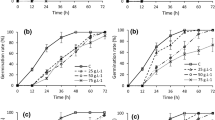Abstract
Five herbicides were evaluated for their potential to reduce reliance on directed white (mineral) spirits applications and hand weeding for grass control in P. caribaea var. hondurensis nurseries. Post-emergent applications of haloxyfop-methyl, fluazifop-P, fenoxaprop-ethyl and sethoxydim were identified as being selective to P. caribaea var. hondurensis seedlings whilst providing effective grass control. Ametryn was toxic to P. caribaea var. hondurensis seedlings at 1 kg ha−1.
Similar content being viewed by others
References
Ahrens, J. F. and Cubanski, M. 1985. Evaluation of post-emergence grass herbicides in conifer seedbeds and Christmas trees. Proc. 39th Annual Meeting of the N.E. Weed Sc. Soc. Connecticut, USA. 243–246.
Bacon, G. J. 1979. An effective pre-emergence weedicide mix for use in Pinus nurseries. South African For. J. 109: 3–6.
Beringer, H. Horlein, G. and Langeluddeke, P. 1982. Hoe 33171 — A new selective herbicide for the control of annual and perennial warm climate grass weeds in broadleaf crops. Proc. 1982 British Crop Protection Conference—Weeds. 11–17.
Costantini, A. 1986. Tolerance of Pinus caribaea var. hondurensis transplants to eleven herbicides. Aust. For. 49(4): 241–245.
Costantini, A., Podberscek, M. and Baxter, A. G. 1989. Directed glyphosate applications in Pinus caribaea var. hondurensis nursery weed management. Qld. Dept. of For. Res. Note 42. 7 pp.
Cousens, R. 1987. Theory and reality of weed control thresholds. Plant Protection Quarterly. 2(1): 13–20.
Hall, M. 1986. Post-emergence weed control in a radiata pine nursery with four selective herbicides. Aust. For. 49(3): 155–159.
Lambert, M. J. 1976. Methods for chemical analysis. Forestry Commission of NSW Tech. Paper No. 25, (not paginated).
Owston, P. W. and Abrahamson, L. P. 1984. Weed management in forest nurseries. pp. 193–202. In: Duryea M. L. and Landis T. D. (Eds) Forest Nursery Manual: Production of Bareroot Seedlings. Boston: Martinus Nijhoff/Dr. W. Junk Publishers.
Queensland Department of Forestry. 1987. Seed Collection and Nursery Cultural Techniques. Brisbane: Queensland Department of Forestry. 23 pp. + app.
Richards, B. N. 1956. Chemical control of weeds in southern pine nurseries. II. White Spirit as a post-emergence weedicide. Aust. For. 20: 13–17.
Seth, A. K. and Fua, J. M. 1984. “Fusilade” — A new post-emergence herbicide for the control of grass weeds in Australia. Proc. 7th Aust. Weeds Conf. Perth, Australia, 145–151.
South, D. B. and Gjerstad, D. H. 1981. Selective post emergence grass control with BAS-9052, RO-13-8895, KK-80 and diclofop in forest nursery seedbeds {Abstract}. Proc. 34th Annual Meet. Sth. Weed Sc. Soc. Auburn: USA p. 207.
Stace, H. C. T., Hubble, G. D., Brewer, R., Northcote, K. H., Sleeman, J. R., Mulcahy, M. J. and Halloworth, E. G. 1968. A Handbook of Australian Soils. Glenside, South Australia: Rellim Technical Publications. 435 ppl.
Van Dorsser, J. C. 1981. Nursery weed control. In forest nursery and establishment practices in New Zealand. F.R.I. Symposium No. 22, 84–101.
Author information
Authors and Affiliations
Rights and permissions
About this article
Cite this article
Costantini, A., Podberscek, M. Tolerance of Pinus caribaea var. hondurensis seedlings to five post-emergence herbicides. New Forest 3, 317–326 (1989). https://doi.org/10.1007/BF00030042
Received:
Accepted:
Issue Date:
DOI: https://doi.org/10.1007/BF00030042




